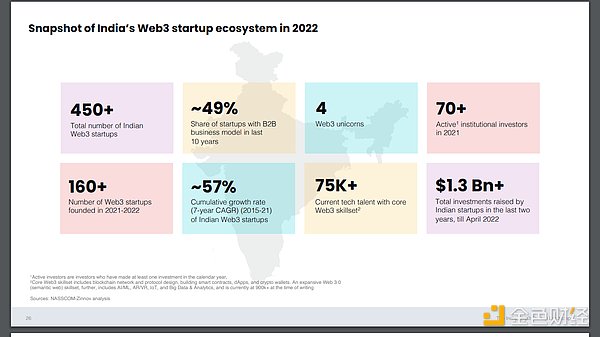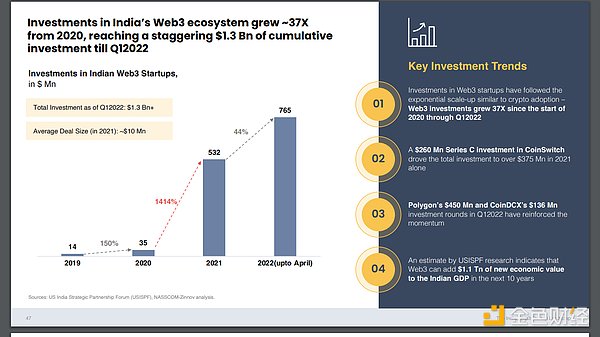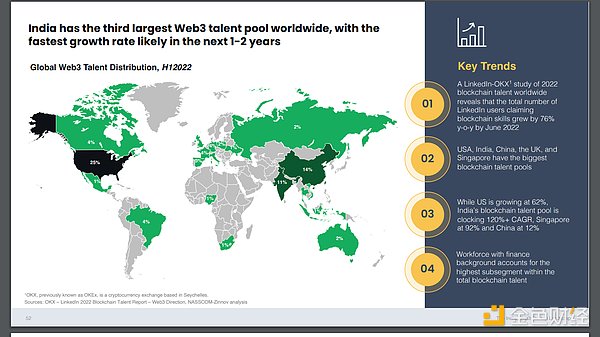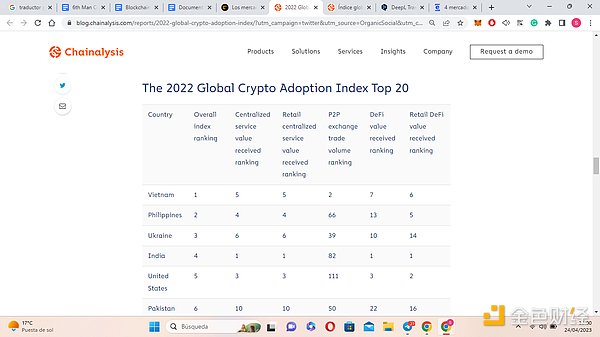Author: Adaverse Research Team
Emerging markets provide unique opportunities for cryptocurrency and blockchain technology. In Africa, cryptocurrency has become an alternative to traditional financial systems and is popular in local markets, especially for those who are unable to access banking services. Blockchain technology has broad application prospects, as it can solve problems such as traceability, identity management, and ownership disputes in supply chains.
In Vietnam, with constant economic growth and increasing technological development, cryptocurrency has quickly captured the hearts of young Vietnamese people, and more and more Vietnamese are using cryptocurrency as a safe and reliable financial option. In India and Africa, where local financial markets lack banking services and local currencies are volatile, cryptocurrency usage is also increasing.
In these regions, digital assets provide a safe and convenient financial solution for local people, and in turn, emerging markets provide unique application scenarios and opportunities for digital asset chains.
Opportunities and Application Scenarios in Emerging Markets
Africa
In Africa, practicality is the key to product success, including Web3 projects. Because the per capita GDP in Africa is relatively low and financial, social, and environmental infrastructure is not yet perfect, solutions in the African market must be able to solve problems or meet clear market scenario needs, including:
-
International Payments: Compared to traditional financial systems, Web3 can achieve faster and cheaper international payments, which is very beneficial for the African financial market because the banking infrastructure in many African countries is underdeveloped.
-
Digital Identity: Web3 can help solve the problem of legal identity by creating a secure, private, and verifiable digital identity.
-
Traceability in the Supply Chain: Blockchain technology can track products along the supply chain, helping to ensure product quality and authenticity and reduce corruption in African agriculture and other sectors.
-
Decentralized Markets: Web3 can facilitate the establishment of decentralized markets, where buyers and sellers can interact directly without intermediaries. This is particularly beneficial for African farmers’ markets, where farmers can sell their products directly to consumers without paying high commissions to intermediaries.
These Web3 use cases can effectively address specific and urgent problems faced by various communities in Africa. Web3’s decentralization makes the platform more flexible in dealing with regional issues, helping to promote inclusive finance and economic development in Africa.
Web3 in Africa is mainly integrated, allowing ordinary consumers to use this technology. A successful case in this regard is Fonbnk, which allows users to exchange their call time credits for cryptocurrency assets.
Africa lacks traditional financial infrastructure, which provides opportunities for new technologies such as blockchain. 57% of African mobile phones are not connected to the Internet, and in some African countries, only 30% of adults have smartphones. In the face of these technological deficiencies, integration and gradual advancement are key.
Not just financial technology
The use cases of Web3 are not only related to the financial market. Blockchain technology has great potential in other non-financial fields on the African continent. In addition to the backwardness of technological infrastructure mentioned above, another major problem in the African region is the lack of reliable and verifiable land ownership records, which has led to many disputes and conflicts.
Currently, companies such as HouseAfrica and Seso Global use blockchain technology to create transparent and immutable records that clearly indicate ownership of land. In addition, blockchain technology can also be used in other fields such as healthcare, education, and digital identity, helping to establish trustworthy and verifiable records in these fields. In short, blockchain technology can help solve different problems in multiple fields in Africa.
India
Although India is also an emerging market with rapid economic growth, its economic development is different from that of other developing economies. On the one hand, India has shown sustained interest in the field of cryptocurrency and tends to support new technologies such as Web3 and blockchain, but on the other hand, the Indian government has not formulated and implemented effective cryptocurrency regulations, causing market chaos and hindering industry development.
Since the Indian Supreme Court overturned the central bank’s ban on digital currency in 2020, the Indian government has debated the regulation and legal status of cryptocurrency, but no clear conclusions have been reached yet.
Considering risks such as money laundering and financial instability, the Reserve Bank of India has been particularly wary of cryptocurrencies, repeatedly emphasizing the scams and fraud cases that have emerged in the Indian cryptocurrency industry, which further exacerbates concerns about blockchain security. Banks and financial companies find it difficult to provide services to Indian cryptocurrency exchanges.
Since the implementation of the new transaction tax law in July 2022, the trading volume of cryptocurrency exchange platforms in India has dropped significantly. The law stipulates a tax of 1% on all cryptocurrency-related transactions exceeding $126 (10,000 Indian rupees). In addition, the Indian government levies a tax of 30% on all cryptocurrency-related income, which has led to the decline in trading volume.
The Great Escape of Indian Cryptocurrencies
Many cryptocurrency companies in India have already considered moving to other jurisdictions-friendly regions such as Singapore or the United Arab Emirates. Dubai is the best choice because the UAE is supportive of cryptocurrencies and has established several tax-free zones that issue cryptocurrency licenses.
Sandeep Nailwal, CEO of Polygon, has said on several occasions that he moved to Dubai two years ago because India’s legal supervision is full of uncertainties, and his company and team could be at risk at any time. Although he hopes to live in India and promote the development of the local Web3 ecosystem, he is concerned about the loss of talent in India’s blockchain field. He lamented that India’s laws and regulations are driving away investors, entrepreneurs, and talent.
Therefore, we can see that India and the UAE differ greatly in Web3 technology and cryptocurrency; India is full of contradictions in cryptocurrency, while the UAE has taken a more positive attitude, and Dubai recently passed a virtual commodity law and established an industry watchdog.
In addition, the UAE has launched a special visa for technology entrepreneurs, allowing them to set up businesses and obtain resources and funding in the country. This policy has attracted many entrepreneurs from all over the world, and Dubai is expected to become a new hub for emerging technologies in the Middle East.
However, for India, the current situation is not the final outcome. Many industry insiders hope that the Indian government will consider India’s potential and try to establish clear and favorable regulations for the industry, actively and substantially changing India’s landscape.
In fact, blockchain technology, cryptocurrency, and Web3 can be applied in various industries, such as:
-
DeFi: The growing DeFi worldwide is also thriving in India, where users can use cryptocurrency and blockchain to access decentralized and intermediary-free financial services, such as loans, savings, and interest income.
-
Digital identity: In India, Web3 can also enhance the security and privacy of users’ digital identities. Storing identities on a blockchain can prevent third parties from accessing personal data without authorization.
-
Intellectual property: Web3 can improve the protection of content creators’ intellectual property rights by allowing them to store and manage their creations on a blockchain, giving them more control over ownership and dissemination of their creations.
India has a large pool of tech talent and a highly skilled and qualified IT workforce, making it ripe for digital assets; India has high technology adoption rates, with a large number of internet users and a growing penetration of smartphones.
In addition, India has always been at the forefront of developing products for the international market. India’s software and IT services industry has always been a major exporter and has achieved great success in providing information technology services globally. Therefore, India has the opportunity to be at the forefront of Web3 innovation and provide solutions to the global market.
Finally, the development of India’s Web3 startup ecosystem is also beginning to take shape. In recent years, investments in cryptocurrency and blockchain startups have increased significantly, with India having over 450 Web3 startups, including the most successful ones such as CoinDCX and CoinSwitch.

Data on India’s Web3 startup ecosystem until 2022, source: Nasscom
From NASSCOM’s recent research, it can be seen that India has a large pool of talent and high adoption rates for digital technology, making it a potential thriving Web3 market. Because the gap between talent supply and demand in India’s technology sector is smaller than in other countries, this means that there is a large pool of tech talent available for Web3 projects.
The adoption rate of cryptocurrency is also significant in India. In particular, investments in Web3 startups have been increasing over the past two years, and the Indian cryptocurrency market is now huge, with about 20 million users. According to USISPF data, this user market could add $1.1 trillion of economic value to India’s GDP over the next 10 years.

Source: Nasscom
The Indian government has launched various initiatives and plans to promote the development of emerging digital technologies, including Web3 and blockchain. Given India’s enormous potential in adopting and developing emerging technologies, blockchain technology will have a significant impact on India’s economy.

Source: Nasscom
Although India ranks third in the global Web3 talent pool, research predicts that India’s talent pool growth rate will be the fastest in the coming years. In addition, India already has a huge talent reserve in emerging technologies such as artificial intelligence and data analytics, and is capable of leading the development of Web3 and blockchain in the future.
Moreover, we need to realize that cryptocurrency and blockchain technology can potentially improve India’s fiscal and tax systems, as India has a relatively complex tax structure and is one of the countries with the highest indirect tax rates in the world. High taxes can reduce consumer purchasing power and business competitiveness, which can harm economic and population development, and may also stimulate economic flight and shadow economy.
Blockchain technology and cryptocurrency may be a solution to these problems. By providing transparent transaction tracking and complete traceability, eliminating unnecessary intermediaries, blockchain technology can reduce entry costs and processing times, benefit small business owners and taxpayers, improve efficiency, and increase trust and transparency in the tax and fiscal system by allowing all participants to access the same information. However, the implementation of these technologies will require appropriate government strategies and regulations.
The Central Bank Digital Currency (CBDC) issued by the Reserve Bank of India (RBI) is designed to replace traditional fiat currency. The CBDC can bring some benefits, including cost reduction, efficiency and financial inclusivity, control of the money supply, reduction of shadow economy, as well as increased security and transparency. However, its implementation requires proper planning and regulation by the government to ensure effectiveness and bring benefits to economic and social development.
Vietnam
According to Chainalysis’ 2022 Global Cryptocurrency Adoption Index, emerging markets in Asia lead in cryptocurrency adoption. Vietnam ranks first, followed by the Philippines. However, despite its impressive performance, in 2018, the State Bank of Vietnam explicitly prohibited the use of cryptocurrency as a means of payment, and companies involved in cryptocurrency transactions were fined.

Top five countries in the Global Cryptocurrency Adoption Index, Source: Chainalysis
Aside from this, Vietnam does not have official regulations related to blockchain technology and cryptocurrency. However, the Prime Minister of Vietnam has approved improved legal frameworks, which is a positive signal that the Vietnamese government recognizes the importance and potential of blockchain technology and is working to establish a clear and secure regulatory framework.
This legal clarity can help promote further growth and development of cryptocurrency and blockchain in Vietnam while limiting the risks these technologies may pose, such as money laundering and terrorist financing.
Overall, Vietnam’s balanced approach to regulating cryptocurrency and blockchain can help promote a healthy and thriving ecosystem and contribute to Vietnam’s economic and technological development in the future.
The fact is that Vietnam has maintained its top position for two consecutive years, laying a solid foundation for the use of cryptocurrency. In addition, Vietnam’s high purchasing power enables people to use centralized cryptocurrencies, DeFi, and P2P tools.
The popularity of blockchain-based games in Vietnam also contributes to the widespread adoption of cryptocurrency. Vietnam has seen some successful cryptocurrency companies, such as Coin98 Finance, Axie Infinity, and Kyber Network, which will encourage more businesses to enter the cryptocurrency market and further increase the popularity of blockchain technology. The Chainalysis report also points out that Vietnam’s cryptocurrency adoption includes centralized and decentralized tools, with both having high proportions. Blockchain-based games, such as P2E and M2E games, are particularly popular.
Vietnam’s cryptocurrency projects are mostly focused on gaming and metadata, followed by DeFi, NFT, and infrastructure. As more traditional companies turn to blockchain and incorporate the technology into their businesses, Vietnam’s cryptocurrency projects have also shown remarkable achievements in fundraising, inspiring confidence in the bright future of Vietnam’s cryptocurrency market.
However, despite the high adoption rates of cryptocurrencies in Vietnam, there is still a need to increase the accessibility and usability of cryptocurrencies. The cryptocurrency industry needs to create concrete solutions that meet the needs of Vietnamese users and users in other middle and high-income countries, in order to increase global adoption of cryptocurrencies.
Blockchain technology for emerging markets
After discussing the opportunities and use cases that blockchain technology brings to emerging markets, we can see the potential of blockchain technology for future economic growth. For retail investors, institutional investors, and governments, blockchain can act as a financial tool and bring significant added value to underdeveloped regions.
Although there is currently no single type of blockchain technology that is suitable for all emerging markets (because each market has its own unique needs and challenges), certain common characteristics of blockchain technology make it a good match for emerging markets. These characteristics include cost-effectiveness, scalability, accessibility, ease of use, and interoperability.
With so many blockchain projects out there, Cardano is particularly well-suited for emerging markets, as it is a blockchain technology designed specifically to cater to them. It emphasizes improving the development of emerging economies through its interoperable, sustainable, and financially inclusive smart contract platform.
In addition, Cardano uses a proof-of-stake consensus mechanism that consumes less energy than other consensus mechanisms used by other blockchain technologies such as Bitcoin, making it more affordable for users in developing countries. Cardano also focuses on education and training, making it suitable for emerging markets with blockchain training and skill development needs.
In terms of functionality, Cardano has a transaction layer that uses the cryptocurrency ADA, and a computation layer based on the Haskell programming language called Plutus, which is mainly used to execute smart contracts (dApps). Overall, Cardano is an emerging technology that offers innovative solutions to the limitations of Bitcoin and Ethereum.
Another highlight of Cardano is its vision. Cardano and Hoskinson’s vision is to create a fairer, more human-centered economy using blockchain technology, and microfinance is a key part of this vision. One example of Cardano’s commitment to solving real-world problems and improving local livelihoods is its partnership with Pezesha to create a P2P financial system in Africa.
Collaborating with Pezesha to create a P2P financial system in Africa is an example of how Cardano is striving to solve real problems and improve economic access for everyone. This collaborative project allows people to borrow and lend money in a regulated way, promoting local financing channels and economic growth.
Pezesha is a Kenyan fintech company focused on small-scale lending for small businesses and individuals in Africa. The joint investment in Africa between the two companies demonstrates Cardano’s commitment to African economic development and its vision of using blockchain technology to solve real-world problems, such as the lack of financing channels. In short, Cardano has the potential to be a blockchain technology that is well-suited for emerging markets.
Blockchain technology can bring benefits to areas that have difficulty obtaining traditional financing, especially in Africa, where small businesses are the backbone of the local economy and the lack of financing channels poses a huge obstacle to their development.
In addition to Cardano, there are other blockchain technologies on the market that are suitable for emerging markets. Here we mainly look at the top three blockchain projects: EOS, Stellar, and Aion.
EOS is a blockchain technology that is very attractive to emerging markets. It focuses on transaction scalability and has high transaction throughput and low transaction latency, which can greatly expand and accelerate payment applications and microtransactions. Block.one has launched several initiatives to encourage the adoption of EOS in emerging markets. For example, in 2019, Block.one announced a partnership with the online gaming platform Ultra to create an EOS-based gaming platform. In addition, Block.one has also launched a $1 billion investment fund to support application development on the EOS platform.
However, like any emerging technology, EOS also faces a series of challenges, including increasingly fierce industry competition, such as Ethereum, which has a large developer base and active community. In addition, security and scalability are key areas of focus for EOS and its community.
In contrast, Stellar’s technology allows anyone, anywhere in the world to conduct token transactions, helping underdeveloped countries and regions with financial systems; another attractive feature of Stellar is that the platform allows for the issuance of tokens and the creation of decentralized applications (dApps) for various purposes, including financial inclusivity and humanitarian aid.
Finally, there is Aion, which is seen as particularly useful for emerging markets as it can provide solutions for interoperability issues that often arise in traditional financial systems in these economies. By achieving interoperability between blockchains, Aion can help drive financial inclusivity in these markets and develop new financial services.
However, before deciding which blockchain technology to use, each case must be evaluated separately, taking into account the specific needs of the market and users.
Conclusion
In recent years, blockchain technology and cryptocurrencies have gained increasing popularity in emerging Asian economies such as India and Vietnam. Many local markets are beginning to use blockchain technology to address financial inclusivity issues and improve efficiency in various industries, such as agriculture and trade.
Blockchain technology and cryptocurrencies can play a meaningful role in promoting financial inclusivity in these emerging markets, offering people financial alternatives that allow them to make more secure and efficient transactions without relying on traditional banking infrastructure.
Furthermore, technologies such as blockchain can help those who lack traditional financial support to obtain funding, particularly small businesses in Africa, which are the backbone of local economies but face significant barriers to growth due to a lack of funding. In contrast, the 16 million cryptocurrency users in the Vietnamese market, spread across gaming, metaverse, DeFi, and NFTs, are a welcome sign.
For India, with its large talent pool, high adoption of digital technology, and growing interest in cryptocurrency and Web3 startups, India is poised to leverage Web3. However, despite having these technological foundations, the Indian government needs to establish clear regulatory frameworks, otherwise it will continue to suffer from brain drain, and the market of 20 million cryptocurrency users will gradually dissolve.
While these emerging markets still face challenges in adopting blockchain technology and cryptocurrencies, it is foreseeable that cryptocurrencies will continue to grow in the coming years. In addition, education on blockchain technology is also booming, and individuals and institutions will become more open and inclusive in their attitudes towards blockchain.
In short, blockchain technology and cryptocurrencies have tremendous potential for development in emerging markets in Asia, such as India and Vietnam, helping to address common problems and challenges in these regions, namely financial inclusivity and industry efficiency. The development of blockchain technology and the spread of related education will further promote growth in these emerging markets.
Like what you're reading? Subscribe to our top stories.
We will continue to update Gambling Chain; if you have any questions or suggestions, please contact us!